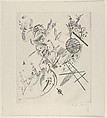Kleine Welten XII (Small Worlds XII)
Vasily Kandinsky French, born Russia
Not on view
Kandinsky made the Small Worlds (Kleine Welten) portfolio while teaching at the Bauhaus, the influential German art school founded after World War I. For Kandinsky, abstraction was a spiritual language. In these poetic images, he creates a vibrant interplay of line and form, while capitalizing on the strengths of each printmaking method, in order to evoke different sensations or "worlds." He used three techniques—drypoint, woodcut, and lithography—each of which had distinct, and for Kandinsky, symbolic, properties. Drypoint, which he regarded as "aristocratic," creates sharp, precise lines, while woodcuts produce a richer texture and depth. Contrasting with these traditional techniques is lithography, which the artist viewed as modern and "democratic" because it offered a smooth surface, a rich vocabulary of colors and marks, and the opportunity to create a seemingly endless number of impressions.
Due to rights restrictions, this image cannot be enlarged, viewed at full screen, or downloaded.

